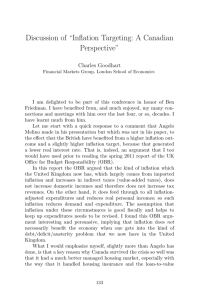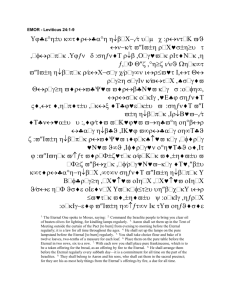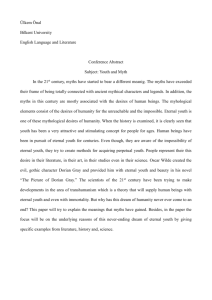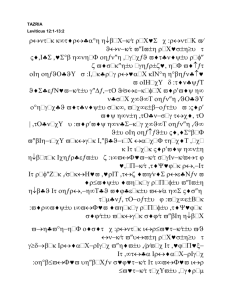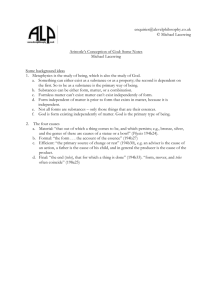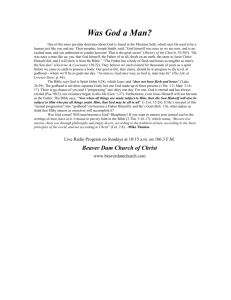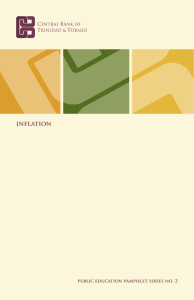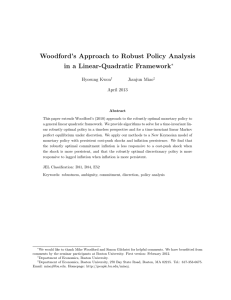as 2-up pdf - KITP Online
advertisement
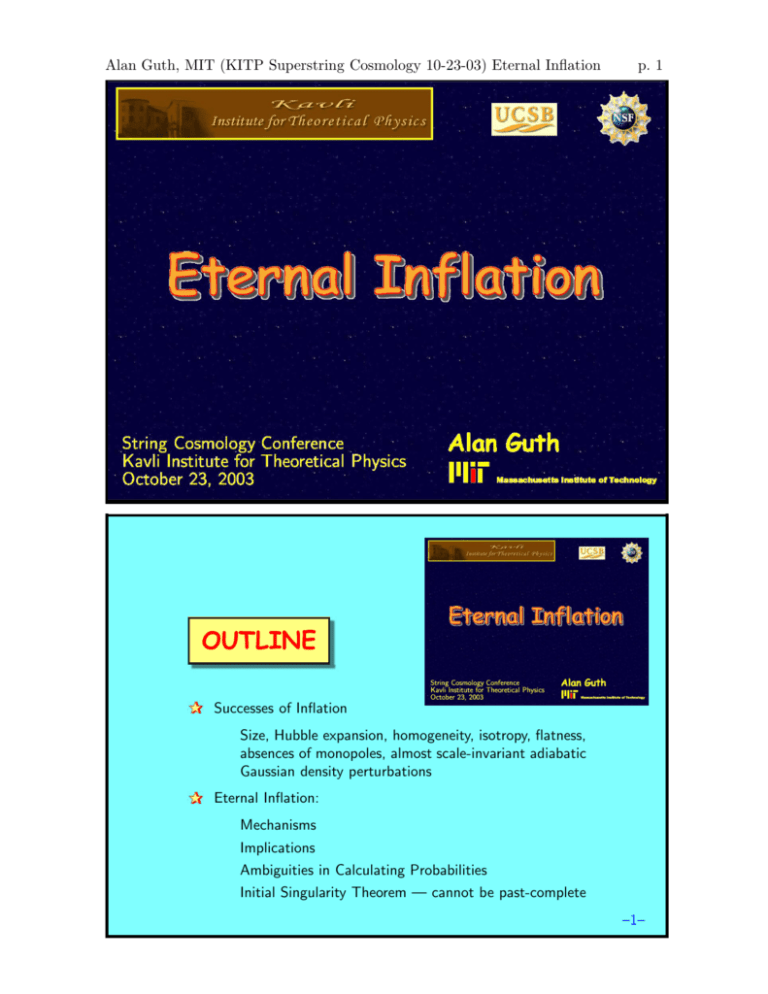
Alan Guth, MIT (KITP Superstring Cosmology 10-23-03) Eternal Inflation p. 1 OUTLINE Successes of Inflation Size, Hubble expansion, homogeneity, isotropy, flatness, absences of monopoles, almost scale-invariant adiabatic Gaussian density perturbations Eternal Inflation: Mechanisms Implications Ambiguities in Calculating Probabilities Initial Singularity Theorem — cannot be past-complete –1– Alan Guth, MIT (KITP Superstring Cosmology 10-23-03) Eternal Inflation p. 2 Successes of Inflation 1) The universe is big— about 1090 particles! 4) Flatness Problem — why was Ω at t = 1 sec equal to 1 to 15 decimal places? 2) Hubble expansion— what was the repulsive driving force? 5) Why no magnetic monopoles? 3) Homogeneity and isotropy— in the conventional big bang (without inflation), CMB uniformity requires communication ∼ 100 times speed of light. 6) Nearly scale invariant, adiabatic, Gaussian density perturbations. –2– –3– Alan Guth, MIT (KITP Superstring Cosmology 10-23-03) Eternal Inflation p. 3 –4– Eternity of Small Field (New) Inflation Essentially all known inflationary models are eternal — once inflation starts it never stops. Small Field Inflation: 1) False vacuum is metastable, and decays exponentially. 2) Volume of false vacuum inflates exponentially. 3) Rate of inflation rate of decay. Volume of false vacuum increases with time! (Steinhardt, 1983; Vilenkin, 1983) –5– Alan Guth, MIT (KITP Superstring Cosmology 10-23-03) Eternal Inflation p. 4 Schematic view of decay of false vacuum (assume each bar is 3 times larger than previous): But: Real universe is 3D, not 1D. Decay of false vacuum is random, not systematic. Inflationary universe has a fractal structure — on scales much too large to observe. If inflation happens once, an infinite number of universes are produced. –6– ETERNAL CHAOTIC INFLATION Andrei Linde showed in 1986 that even chaotic inflation can be eternal. One needs to consider quantum fluctuations of φ: Quantum fluctuations play a conspicuous role in inflating spacetimes: For static spaces, quantum fluctuations are important on small scales, but only on small scales. For inflating spaces, the small scale quantum fluctuations are constantly stretched to classical sizes. Simple random walk picture: In each time interval ∆t = H −1 , the average field φ in each region of size H −1 receives a random increment with root mean square ∆φqu = H/2π. This random increment is superimposed on the classical motion, which is downward. –7– Alan Guth, MIT (KITP Superstring Cosmology 10-23-03) Eternal Inflation p. 5 Quantum fluctuations are equally likely to move φ up or down the hill. BUT: suppose φ = φ0 at the start of some time interval ∆t = H −1 . During ∆t, the volume expands by e3 ≈ 20. If the fraction of space in which φ increases is > 1/e3 , then volume of region with φ > φ0 INCREASES. If so, inflation never ends. In equations, the probability of an upward fluctuation exceeds 1/e3 if H H2 > 0.61 |φ̇cl | H −1 ⇐⇒ ∆φqu ≈ > 3.8 . 2π |φ̇cl | But δρ H2 ∼ (scalar density perturbations), ρ |φ̇cl | so the criterion for eternal inflation is that the density perturbations on very long wavelengths are O(1). > 0.75λ−1/6 Mp , inflation will be For example, for a V = λφ4 theory, if φ ∼ eternal. Note that energy density ∼ 0.08λ1/3 Mp4 , which can be considerably below the Planck scale. –8– Unanswered questions about eternal chaotic inflation: ? In this calculation, the regions in which φ fluctuates upward to Planckian energies dominate the volume. What really happens when the energy density becomes Planckian? ? Can we find a more fully quantum mechanical description of eternal inflation? –9– Alan Guth, MIT (KITP Superstring Cosmology 10-23-03) Eternal Inflation p. 6 Implications of Eternal Inflation 1) Hypotheses about initial conditions become divorced from observation. Inflating network presumably approaches steady state. 2) Plausibility of inflation beginning becomes (almost) irrelevant — need only begin once in all eternity. (How could inflation NOT begin!?) In particular, small field inflation (i.e., “new” inflation) is certainly not dead. –10– 3) The spatial volume grows without bound. This leads to deep questions about the number of degrees of freedom: It is hard to imagine how a finite number of degrees of freedom can describe an ever-enlarging multiverse. If the number of degrees of freedom is infinite, then either all states with Λ > 0 are unstable, or the eternally inflating spacetime is not asymptotically de Sitter (Banks & Fischler, 2003). If the number of degrees of freedom is infinite, then either a) Degrees of freedom are created as the multiverse expands, or b) The universe begins with an infinite number of degrees of freedom, but all are frozen except for a finite number. As the multiverse enlarges, more and more degrees of freedom are unfrozen. Conceivably string theory might imply that the number of degrees of freedom is finite, and therefore eternal inflation can’t happen. But I find it hard to believe that string theory can forbid such a simple consequence of combining quantum field theory with GR. –11– Alan Guth, MIT (KITP Superstring Cosmology 10-23-03) Eternal Inflation 4) p. 7 Inflation could conceivably help to save the predictive power of string theory. (To me the “anthropic principle” is the explanation of last resort, so I don’t want to give in to it until we are sure that there is no better explanation for the world around us.) Even if there are 101000 vacuum-like states of string theory, maybe inflation produces overwhelmingly more of one type of vacuum than the others. In eternally inflating scenarios, presumably the state(s) with the fastest exponential expansion rate dominates — probably by an infinite amount. But all states in the decay chain of this state will also grow with the same exponential. Our universe should then be found in the decay chain of the dominating state. The decay chain may be complicated, but maybe it will be far smaller than the full landscape of string theory vacua. At the present time this idea is only wishful thinking, but we are presumably in the earliest stages of understanding the vacua of string theory. –12– Ambiguities in the Calculation of Probabilities Anything that can happen will happen; so the implications of eternal inflation must be described in terms of probabilities. But in the infinite spacetime, the fraction with any particular property is infinity/infinity. If one regularizes by cutting out a finite spacetime volume, the answer depends on how one chooses the cutoff. Suppose one cuts of the distribution by stopping at some fixed time, say in a synchronous coordinate system. Then one finds peculiar effects. The rate of production of new pocket universes is growing 10−37 second. For every pocket exponentially with a time constant of37perhaps that are 1 sec younger! The result is universe of age t, there are exp 10 an incredibly youth-dominated “society”. The Youngness Paradox: All historical inferences are distorted, because the probability 37 of any scenario that can “get us here” 1 sec faster is enhanced by exp 10 . –13– Alan Guth, MIT (KITP Superstring Cosmology 10-23-03) Eternal Inflation p. 8 Suppose one cuts of the distribution by stopping at some fixed time, say in a synchronous coordinate system. Then one finds peculiar effects. The rate of production of new pocket universes is growing 10−37 second. For every pocket exponentially with a time constant of37perhaps that are 1 sec younger! The result is universe of age t, there are exp 10 an incredibly youth-dominated “society”. The Youngness Paradox: All historical inferences are distorted, because the probability of any scenario that can “get us here” 1 sec faster is enhanced by exp 1037 . Do we live in the center of the world?, by Linde, Linde, & Mezhlumian, 1994: used such an argument to show that we most likely live near the center of a spherical hole in the cosmic density distribution. Vilenkin and collaborators (Garriga, Tanaka, Vanchurin, Winitzki) have shown that these conclusions can be avoided with an alternative method of calculation, but I believe that it is still unclear how one decides on the right method of calculation. –14– Eternal to Past? | Probably Not A relevant theorem was proved recently by Borde, Vilenkin, and me (gr-qc/0110012, PRL 2003). When a geodesic observer moves through an expanding space, she slows down (redshift). The redshift is a purely kinematical effect, independent of the dynamics of GR, and therefore independent of any energy conditions. To see this, imagine a universe with 1D space, and imagine that the comoving particles are cars. Consider a geodesic observer moving relative to them. In observer’s frame, the cars are moving by. If the first car passes at 70 km/hr, and the cars are moving apart, then the next car will not pass at 80 km/hr! If we follow the observer backwards in an expanding universe, she speeds up. But, the calculation shows that if Haverage > 0 in the past, then she will reach the speed of light in a finite proper time. –15– Alan Guth, MIT (KITP Superstring Cosmology 10-23-03) Eternal Inflation p. 9 Consider a geodesic observer (timelike or null trajectory) moving through an expanding universe: The observer measures the velocities uµ (τ ) of the “comoving geodesic test particles” that she passes, and from their motion she infers a local, unidirectional Hubble parameter H≡ ∆vradial . ∆r The comoving test particles need not exist. It merely must be be possible to define the velocity fields, with aproper = 0 at the time each test particle is passed. The relative velocity between the test particles and the geodesic observer can be described by 1 γ ≡ uµ v µ = , 2 1 − vrel where the 2nd equality holds only for timelike geodesics. –16– The redshifting (slowing down) of the relative velocity is directly related to the measurement of H : dF (γ) H= , dτ where −1 γ for null observers F (γ) = arctanh(1/γ) for timelike observers . F (γ) = “slowness” . So, for geodesic observers moving at relative speed vrel at time τf , τf 1 2 H dτ ≤ arctanh = arctanh 1 − vrel . γ For null observers, if we normalize the affine parameter τ by dτ /dt = 1 at τf , then τf H dτ ≤ 1 . –17– Alan Guth, MIT (KITP Superstring Cosmology 10-23-03) Eternal Inflation p. 10 Example: de Sitter space in flat coordinates: ds2 = −dt2 + e2Ht dx2 . A comoving geodesic (x = constant) has infinite length, but any other backwards-going geodesic reaches t = −∞ in a finite proper time. The de Sitter spacetime can of course be extended beyond t = −∞, and the full de Sitter spacetime is of course geodesically complete. However, the expanding phase must be preceded by a contracting phase, which is not part of an inflationary model. If the spacetime is extended beyond t = −∞, the theorem implies that H must become negative. –18– Application to Inflationary Models: The theorem can then be summarized by saying that any spacetime for which Hav > 0 along any past-directed geodesic cannot be geodesically complete in the past. In particular, the cyclic ekpyrotic model has Hav > 0 for null geodesics for a single cycle, and since every cycle is identical, Hav > 0 when averaged over all cycles. Therefore the cyclic model is past-incomplete, and requires a boundary condition in the past. –19– Alan Guth, MIT (KITP Superstring Cosmology 10-23-03) Eternal Inflation p. 11 Disclaimers: There is of course no conclusion that an eternally inflating model must have a unique beginning, and no conclusion that there is an upper bound on the length of all backwards-going geodesics from a given point. There may be models with regions of contraction embedded within the expanding region that could evade our theorem. Aguirre & Gratton have proposed a model that evades our theorem, in which the arrow of time reverses at the t = −∞ hypersurface, so the universe “expands” in both halves of the full de Sitter space. Claim: to Hav An eternally inflating model of the type usually assumed, which would lead > 0 for past-directed geodesics, cannot be complete. Some new physics (i.e., not inflation) would be needed to describe the past boundary of the inflating region. One possibility would be a quantum origin. –20– SUMMARY The inflationary paradigm is in great shape! Inflation can explain the large size, the Hubble expansion, the homogeneity, isotropy, and flatness of the universe. Can also explain the absence of monopoles, and the nearly scale-invariant adiabatic Gaussian density perturbations. Both small field and large field inflationary models are generically eternal into the future. Eternal inflation divorces the initial condition problem from observation, makes the probability of inflation starting irrelevant (if nonzero), raises questions about the number of degrees of freedom, and offers the possibility that inflation MIGHT choose a preferred class of vacuum states. Although eternal inflation seems inevitable and has attractive features, the problem of calculating probabilities in an eternally inflating universe remains unclear. Eternally inflating models, including the cyclic ekpyrotic model, are pastincomplete — some new physics (quantum origin?) is needed to describe the past boundary of the inflating region. –21–
